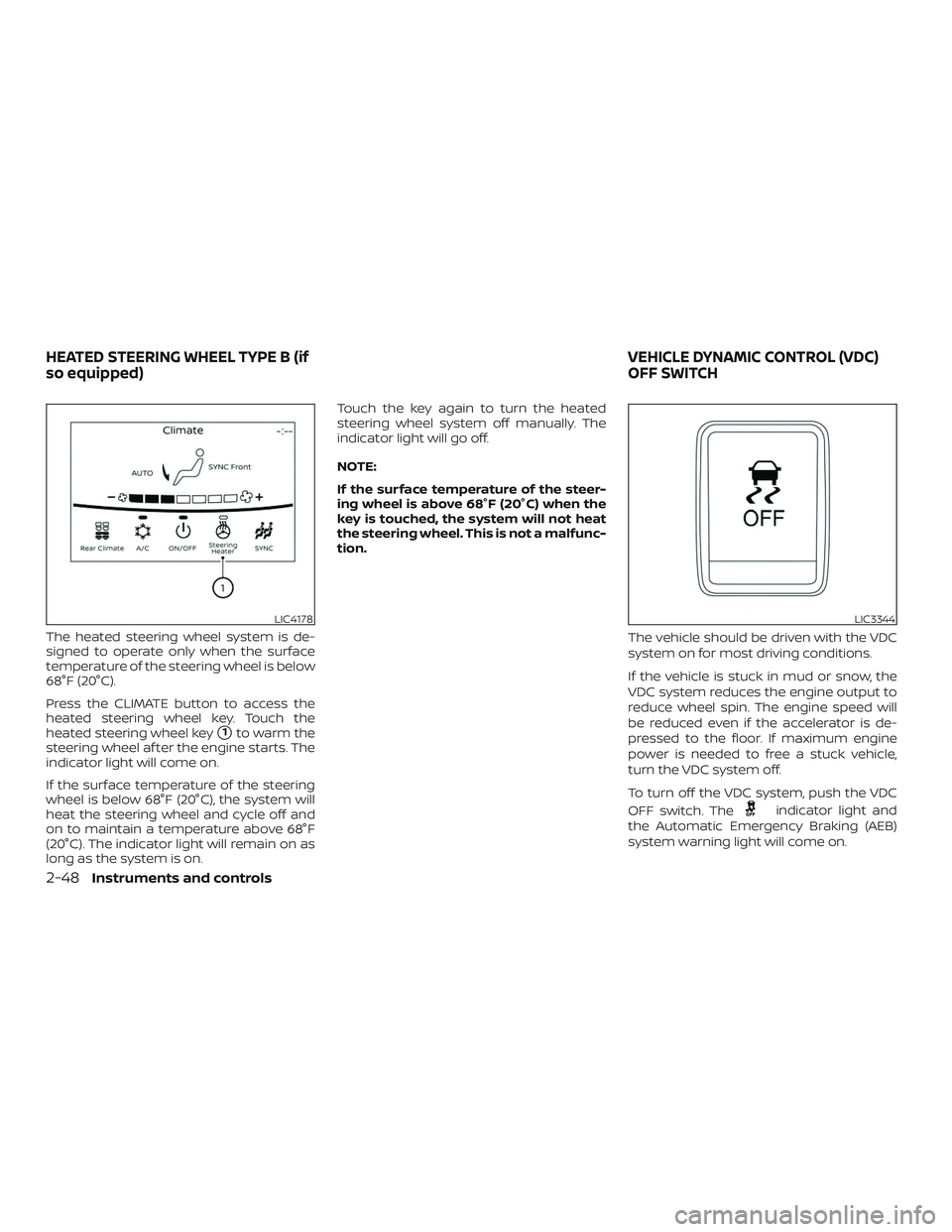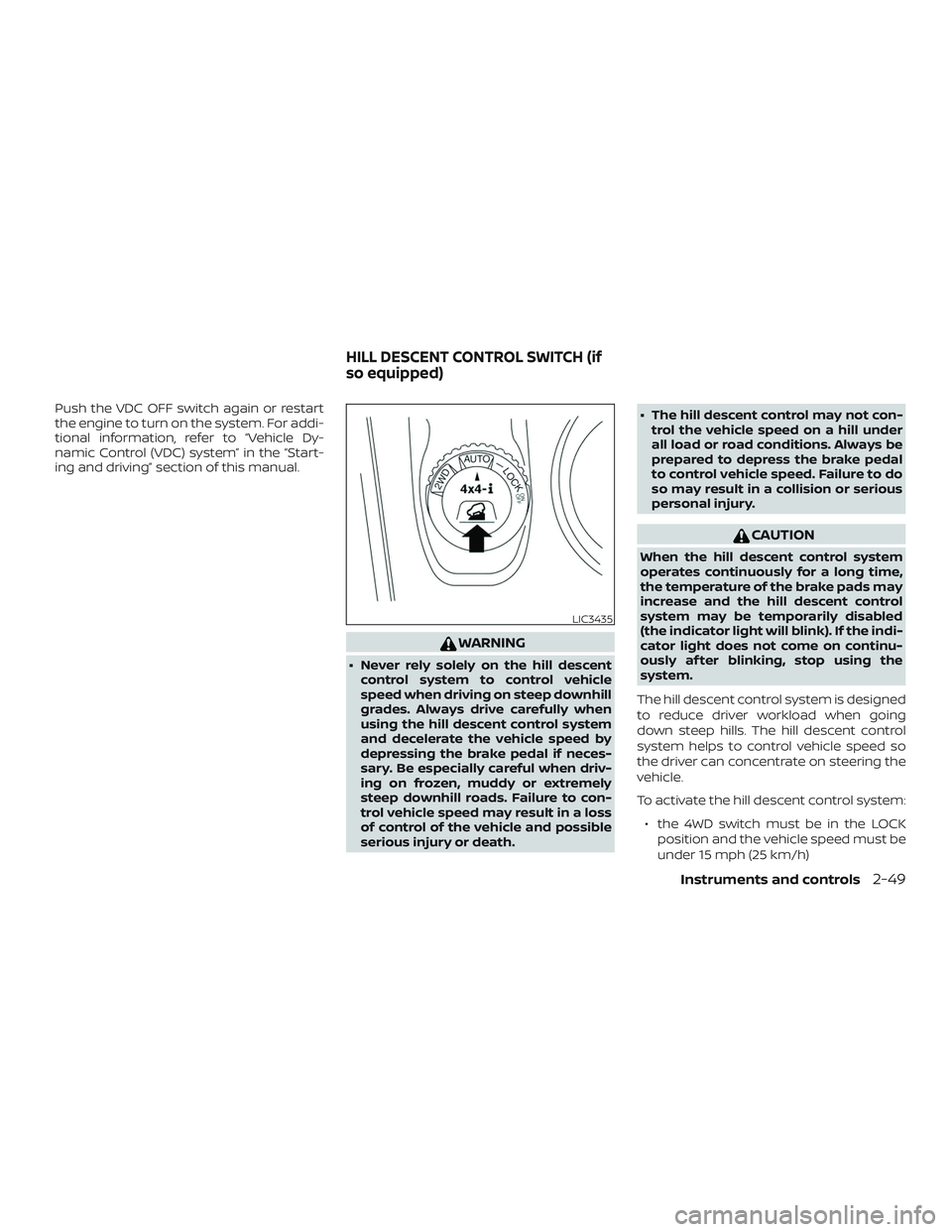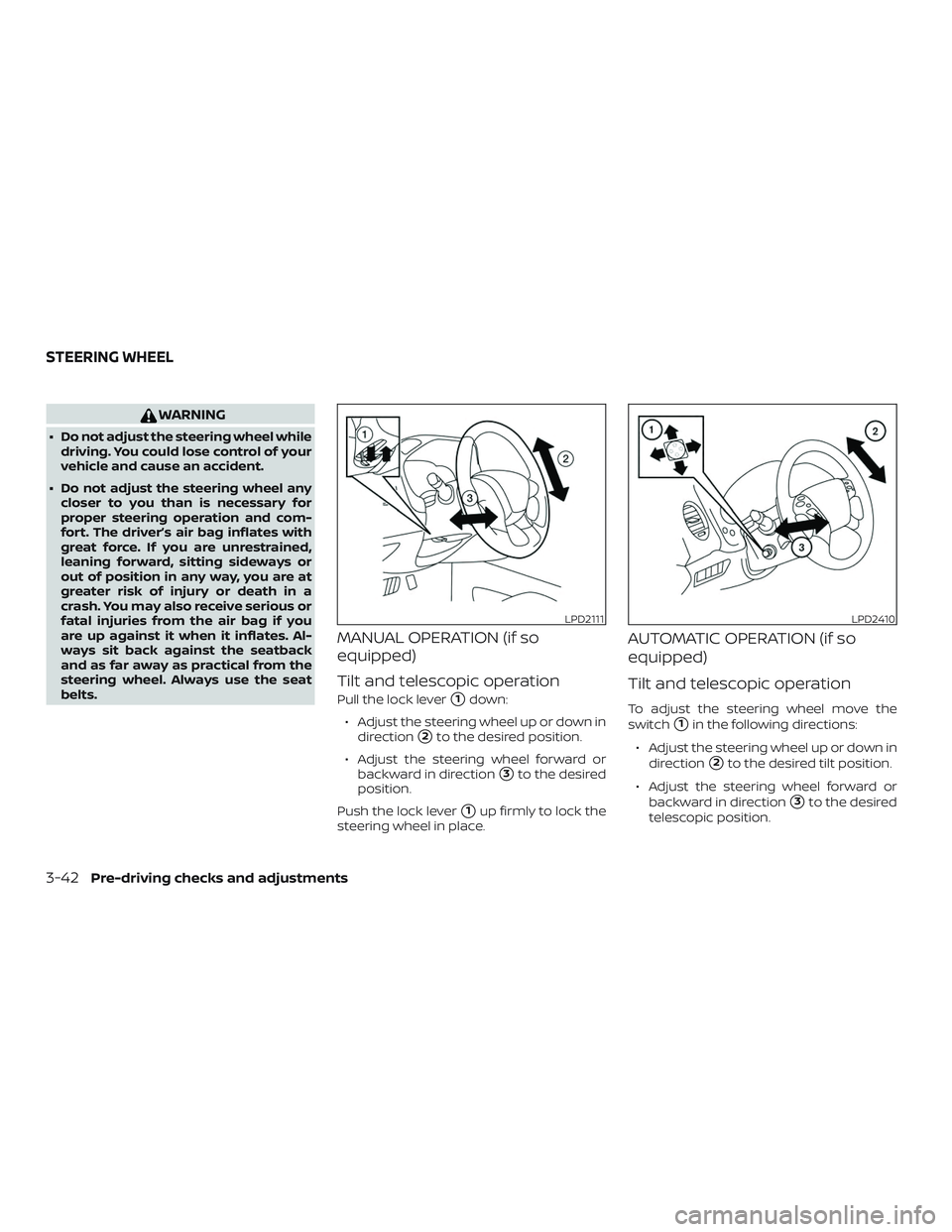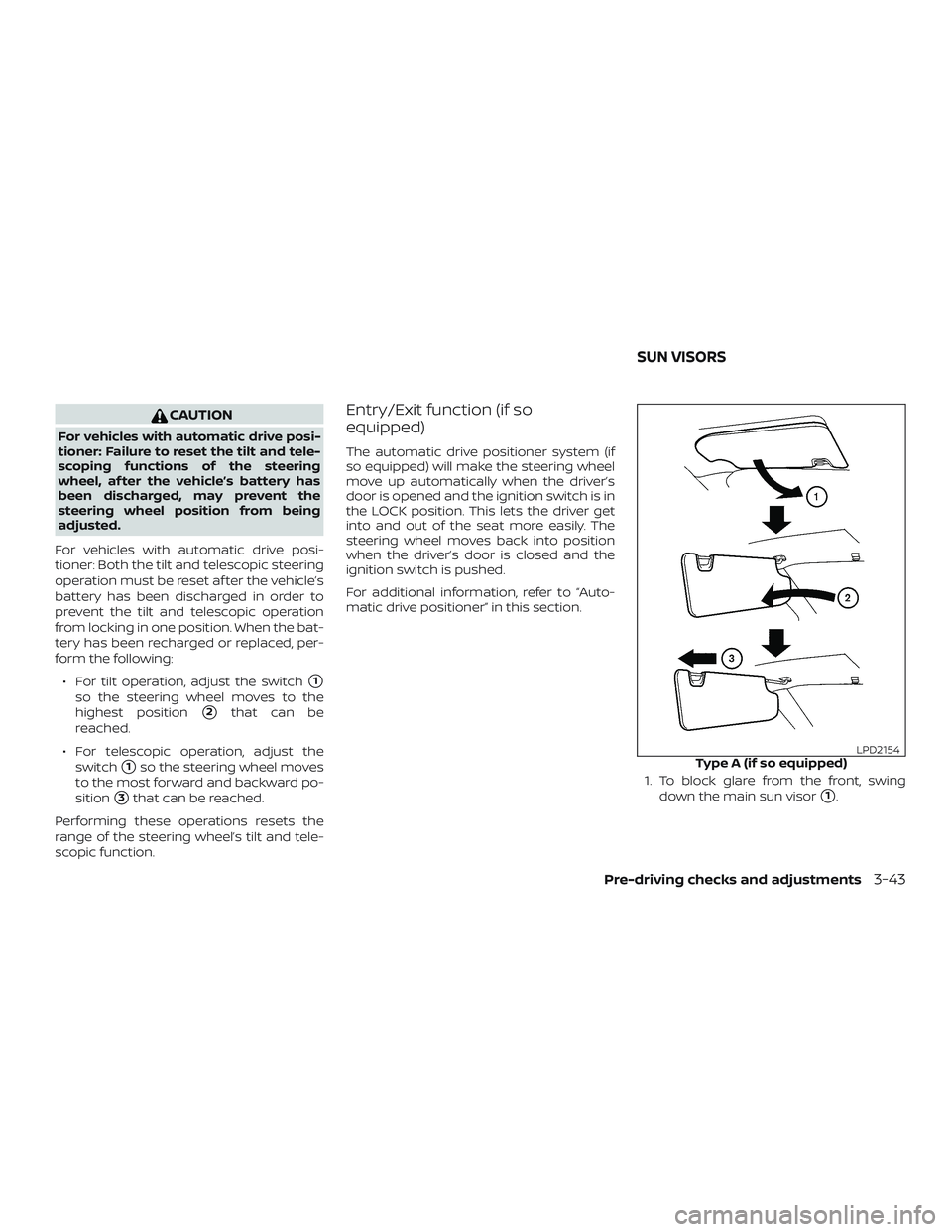Page 139 of 476
FOG LIGHT SWITCH (if so
equipped)
To turn the fog lights on, rotate the head-
light switch to the
position, then ro-
tate the fog light switch to the
posi-
tion.
To turn the fog lights on with the headlight
switch in the AUTO position, the headlights
must be on, then rotate the fog light switch
to the
position.
To turn the fog lights off, rotate the fog light
switch to the OFF position. The headlights must be on and the low
beams selected for the fog lights to oper-
ate. The fog lights automatically turn off
when the high beam headlights are se-
lected.
To sound the horn, push the center pad
area of the steering wheel.
LIC3256LIC2227
HORN
Instruments and controls2-43
Page 143 of 476
3. When the seat is warmed or before youleave the vehicle, be sure to turn the
switch off.
The heated steering wheel system is de-
signed to operate only when the surface
temperature of the steering wheel is below
68°F (20°C).
Push the heated steering wheel switch to
warm the steering wheel af ter the engine
starts. The indicator light will come on.
If the surface temperature of the steering
wheel is below 68°F (20°C), the system will
heat the steering wheel and cycle off and
on to maintain a temperature above 68°F
(20°C). The indicator light will remain on as
long as the system is on. Push the switch again to turn the heated
steering wheel system off manually. The
indicator light will go off.
NOTE:
If the surface temperature of the steer-
ing wheel is above 68°F (20°C) when the
switch is turned on, the system will not
heat the steering wheel. This is not a
malfunction.
LIC0421
HEATED STEERING WHEEL SWITCH
TYPE A (if so equipped)
Instruments and controls2-47
Page 144 of 476

The heated steering wheel system is de-
signed to operate only when the surface
temperature of the steering wheel is below
68°F (20°C).
Press the CLIMATE button to access the
heated steering wheel key. Touch the
heated steering wheel key
�1to warm the
steering wheel af ter the engine starts. The
indicator light will come on.
If the surface temperature of the steering
wheel is below 68°F (20°C), the system will
heat the steering wheel and cycle off and
on to maintain a temperature above 68°F
(20°C). The indicator light will remain on as
long as the system is on. Touch the key again to turn the heated
steering wheel system off manually. The
indicator light will go off.
NOTE:
If the surface temperature of the steer-
ing wheel is above 68°F (20°C) when the
key is touched, the system will not heat
the steering wheel. This is not a malfunc-
tion.
The vehicle should be driven with the VDC
system on for most driving conditions.
If the vehicle is stuck in mud or snow, the
VDC system reduces the engine output to
reduce wheel spin. The engine speed will
be reduced even if the accelerator is de-
pressed to the floor. If maximum engine
power is needed to free a stuck vehicle,
turn the VDC system off.
To turn off the VDC system, push the VDC
OFF switch. The
indicator light and
the Automatic Emergency Braking (AEB)
system warning light will come on.
LIC4178LIC3344
HEATED STEERING WHEEL TYPE B (if
so equipped) VEHICLE DYNAMIC CONTROL (VDC)
OFF SWITCH
2-48Instruments and controls
Page 145 of 476

Push the VDC OFF switch again or restart
the engine to turn on the system. For addi-
tional information, refer to “Vehicle Dy-
namic Control (VDC) system” in the “Start-
ing and driving” section of this manual.
WARNING
∙ Never rely solely on the hill descentcontrol system to control vehicle
speed when driving on steep downhill
grades. Always drive carefully when
using the hill descent control system
and decelerate the vehicle speed by
depressing the brake pedal if neces-
sary. Be especially careful when driv-
ing on frozen, muddy or extremely
steep downhill roads. Failure to con-
trol vehicle speed may result in a loss
of control of the vehicle and possible
serious injury or death. ∙ The hill descent control may not con-
trol the vehicle speed on a hill under
all load or road conditions. Always be
prepared to depress the brake pedal
to control vehicle speed. Failure to do
so may result in a collision or serious
personal injury.
CAUTION
When the hill descent control system
operates continuously for a long time,
the temperature of the brake pads may
increase and the hill descent control
system may be temporarily disabled
(the indicator light will blink). If the indi-
cator light does not come on continu-
ously af ter blinking, stop using the
system.
The hill descent control system is designed
to reduce driver workload when going
down steep hills. The hill descent control
system helps to control vehicle speed so
the driver can concentrate on steering the
vehicle.
To activate the hill descent control system: ∙ the 4WD switch must be in the LOCK position and the vehicle speed must be
under 15 mph (25 km/h)
LIC3435
HILL DESCENT CONTROL SWITCH (if
so equipped)
Instruments and controls2-49
Page 152 of 476
The extended storage switch is used when
the vehicle is in transit from the factory. It is
located in the fuse panel to the lef t of the
steering wheel on the instrument panel. If
any electrical equipment does not operate,
ensure the extended storage switch is
pushed fully in place, as shown.
LDI2758
Pulled position
LIC3266
Pushed position
LIC3268
EXTENDED STORAGE SWITCH
2-56Instruments and controls
Page 174 of 476

3 Pre-driving checks and adjustments
Keys.............................................3-2NISSAN Intelligent Key® .......................3-2
NISSAN Vehicle Immobilizer System
keys..........................................3-4
Doors ...........................................3-5
Locking with key ..............................3-5
Locking with inside lock knob .................3-6
Locking with power door lock switch ......... 3-7
Automatic door locks......................... 3-7
Child safety rear door lock .................... 3-7
NISSAN Intelligent Key® With Door and
Lif tgate Request Switches .......................3-8
Operating range ..............................3-9
Door locks/unlocks precaution ..............3-10
NISSAN Intelligent Key® Operation ............3-11
How to use the remote keyless entry
function ..................................... 3-14
Warning signals ............................. 3-18
Troubleshooting guide ......................3-18
NISSAN Intelligent Key® Without Door and
Lif tgate Request Switches ......................3-21
Operating range ............................. 3-22
How to use the remote keyless entry
function ..................................... 3-22Warning signals
............................. 3-26
Troubleshooting guide ......................3-27
Remote Engine Start (if so equipped) ...........3-29
Remote Engine Start operating range .......3-29
Remote starting the vehicle .................3-30
Extending engine run time ..................3-30
Canceling a Remote Engine Start ............3-30
Conditions the Remote Engine Start will
notwork .................................... 3-31
Hood ........................................... 3-32
Lif tgate ......................................... 3-32
Operating the manual lif tgate
(if so equipped) .............................. 3-33
Operating the power lif tgate
(if so equipped) .............................. 3-33
Motion-Activated Lif tgate
(if so equipped) .............................. 3-36
Lif tgate release .............................. 3-37
Lif tgate position setting
(if so equipped) .............................. 3-38
Fuel-filler door .................................. 3-39
Opening the fuel-filler door ..................3-39
F
uel-filler cap ................................ 3-39
Steering wheel ................................. 3-42
Page 216 of 476

WARNING
∙ Do not adjust the steering wheel whiledriving. You could lose control of your
vehicle and cause an accident.
∙ Do not adjust the steering wheel any closer to you than is necessary for
proper steering operation and com-
fort. The driver’s air bag inflates with
great force. If you are unrestrained,
leaning forward, sitting sideways or
out of position in any way, you are at
greater risk of injury or death in a
crash. You may also receive serious or
fatal injuries from the air bag if you
are up against it when it inflates. Al-
ways sit back against the seatback
and as far away as practical from the
steering wheel. Always use the seat
belts.
MANUAL OPERATION (if so
equipped)
Tilt and telescopic operation
Pull the lock lever�1down:
∙ Adjust the steering wheel up or down in direction
�2to the desired position.
∙ Adjust the steering wheel forward or backward in direction
�3to the desired
position.
Push the lock lever
�1up firmly to lock the
steering wheel in place.
AUTOMATIC OPERATION (if so
equipped)
Tilt and telescopic operation
To adjust the steering wheel move the
switch
�1in the following directions:
∙ Adjust the steering wheel up or down in direction
�2to the desired tilt position.
∙ Adjust the steering wheel forward or backward in direction
�3to the desired
telescopic position.
LPD2111LPD2410
STEERING WHEEL
3-42Pre-driving checks and adjustments
Page 217 of 476

CAUTION
For vehicles with automatic drive posi-
tioner: Failure to reset the tilt and tele-
scoping functions of the steering
wheel, af ter the vehicle’s battery has
been discharged, may prevent the
steering wheel position from being
adjusted.
For vehicles with automatic drive posi-
tioner: Both the tilt and telescopic steering
operation must be reset af ter the vehicle’s
battery has been discharged in order to
prevent the tilt and telescopic operation
from locking in one position. When the bat-
tery has been recharged or replaced, per-
form the following: ∙ For tilt operation, adjust the switch
�1
so the steering wheel moves to the
highest position
�2that can be
reached.
∙ For telescopic operation, adjust the switch
�1so the steering wheel moves
to the most forward and backward po-
sition
�3that can be reached.
Performing these operations resets the
range of the steering wheel’s tilt and tele-
scopic function.
Entry/Exit function (if so
equipped)
The automatic drive positioner system (if
so equipped) will make the steering wheel
move up automatically when the driver’s
door is opened and the ignition switch is in
the LOCK position. This lets the driver get
into and out of the seat more easily. The
steering wheel moves back into position
when the driver’s door is closed and the
ignition switch is pushed.
For additional information, refer to “Auto-
matic drive positioner” in this section.
1. To block glare from the front, swingdown the main sun visor
�1.
Type A (if so equipped)LPD2154
SUN VISORS
Pre-driving checks and adjustments3-43